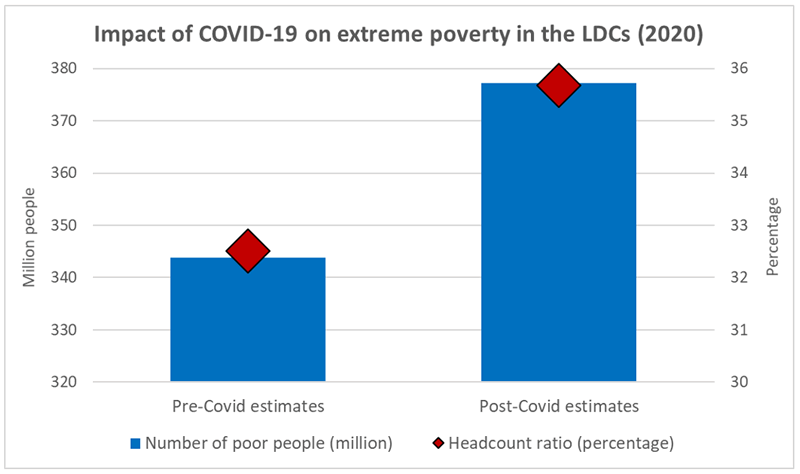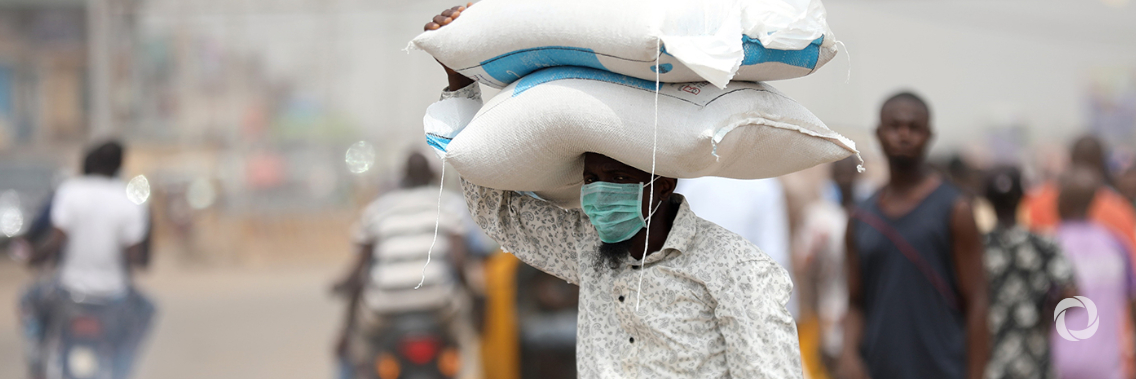As the number of COVID-19 cases continues to rise in Africa and Southern Asia, and the global economy enters a synchronized recession unseen since the Second World War, the world’s poorest countries brace for yet another shock that threatens to deepen global inequalities and exacerbate an already challenging situation.
Public health and socio-economic concerns are deeply intertwined all over the world, but all the more so in contexts like the least developed countries (LDCs).
Indeed, even though two-thirds of people in LDCs live in rural areas, many of them reside in overcrowded urban settlements lacking basic services. They can hardly cope with strict social distancing, as well as broader economic shocks that directly affect their income.
Even prior to the emergence of the COVID-19 pandemic, respectable gross domestic product (GDP) growth rates in the 47 LDCs were only weakly translating into inclusive social outcomes.
The decline in poverty headcount ratios had markedly decelerated in the aftermath of the 2009 global financial crisis.
Over the last decade, it has been so sluggish that the number of people living in extreme poverty (i.e. below $1.90/day) in the LDCs has increased from 340 million people in 2010 to an estimated 349 million in 2018. This was largely due to the situation in African LDCs.
The interplay between the COVID-19 outbreak, the contraction in demand – globally and even more so in some of LDCs’ major trading markets – and the free-fall of international commodity prices will likely reverse the limited progress that has been made in poverty reduction.
This will steer us even further away from achieving the first United Nations Sustainable Development Goal of ending poverty in all its forms everywhere.
To provide a preliminary appraisal of the impact of COVID-19 on LDC poverty levels, UNCTAD has examined the International Monetary Fund’s growth forecasts in GDP per capita (in constant 2011 international dollars) and looked at the effects, stemming from its downward revision following the outbreak of the pandemic.
This allows the direct comparison of poverty estimates consistent with the IMF’s reassessment of growth forecasts between October 2019 and April 2020.
The results of this UNCTAD research are highlighted in the below figure:

Yet, there are considerable risks that the crisis may deepen or even linger on beyond the end of 2020, especially if it triggers a balance of payment tensions and/or debt crises in the developing world.
Mitigating this adverse effect hinges on a four-pronged approach:
1️⃣ First, the international community must support LDC governments in mobilizing adequate resources to allow their health systems to cope with the emergency, while also assisting vulnerable segments of the population.
2️⃣ Second, containing the social costs of the pandemic requires averting balance of payment crises that would further strain LDC economies, and risk triggering food shortages as most countries in the category are net food importers.
3️⃣ Thirdly, it is crucial to avoid major disruptions to domestic and regional food and agricultural value chains.
4️⃣ Fourthly, in the longer-term, international cooperation must be revamped to:
-
- Adopt concerted expansionary policies to blunt the impact of the crisis and revitalize the global economy.
- Redouble investments in sustainable development, thus spurring the transition towards a low-carbon economy.
- Keep critical value chains (such as food and medical equipment) viable, thus avoiding the painful mistakes that followed the 2007-2008 food crisis; and finally.
- Foster productive capacity development and structural transformation in LDCs as key elements of a policy package to build resilience and lay a robust foundation for employment creation.
Original source: UNCTAD
Published on 04 May 2020

